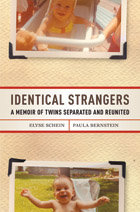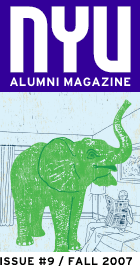memoir
A Tale of Two Sisters
An intimate project helps twins bridge decades of separation
by Courtney E. Martin / GAL '04
On an ordinary April morning in 2004, Paula Bernstein’s (TSOA '92) past and future collided in a phone call from Louise Wise Services, the agency that arranged her adoption in 1969. A freelance writer, she had published an essay in Redbook in 2000 titled, “Why I Don’t Want to Find My Birth Mother”—and had long ago made that clear to the agency, suspecting that to discover another family might end in heartbreak. But it wasn’t her birth mother they were calling about. “I hate to dump this on you,” a woman told her over the phone, “but you've got a twin!”After recovering from the shock, Bernstein and her sister, Paris-based filmmaker Elyse Schein, who had contacted the agency in search of her birth mother, reunited at Café Mogador, an East Village haunt Bernstein frequented as a graduate student in cinema studies. They reveled in a love-at-first-sight euphoria, comparing knees, noses, and what once seemed anomalous quirks. "Even when I'm not in front of a keyboard, I find myself mock typing while I speak," Bernstein admitted. "I do that too!" Schein exclaimed. They shared childhood histories—Bernstein's idyllic upbringing in Westchester and Schein's early loss of her adoptive mother in Oklahoma. Both were editor-in-chief of their high school newspapers and passionate about avant-garde film.
The twins soon decided to document their discovery in writing, agreeing it would be an ideal way to get to know each other and make sense of their newfound sisterhood; Identical Strangers: A Memoir of Twins Separated and Reunited (Random House) was published in October 2007. The book reads like a mystery as it follows the sisters in their quest to understand who their mother was, why they were separated, and how this information has changed them. To find these answers, they interview twin experts, dig through birth records, and analyze the science and cultural lore of identical twins, including director Stanley Kubrick's study of duality and identity in The Shining (1980) and Diane Arbus's 1967 photograph of identical girl twins—dressed the same and yet still so individual.
What they uncover is a tale of a mentally ill mother of twin baby girls, separated because of an ethically questionable study on nature versus nurture, so controversial it has been sealed until 2066. The sisters interrogate the lead scientist of the secret study and, with the help of a private investigator, discover the truth about their mother's fate.
Yet even as they worked together, they had to confront the fact that, DNA aside, they were still virtual strangers. While Schein described Bernstein, a married mother of two in Brooklyn, as "'the we of me' that I had been unconsciously searching for all my life," Bernstein, worried that her new sister—unmarried and unmoored—would want too much from her. "Writing about some of the difficult aspects of our relationship wasn't easy," Bernstein concedes. "I was definitely afraid of hurting her feelings." Schein adds: "Communication is always difficult, but in this case, it was sometimes like speaking a foreign language. You're not sure if the other person really understands you."

AFTER DISCOVERING EACH OTHER IN
THEIR THIRTIES, TWINS ELYSE SCHEIN
(LEFT) AND PAULA BERNSTEIN HAD
TO LEARN HOW TO BE SISTERS.
It's a strange dilemma for identical twins, known for sometimes inventing their own language when raised together, but Bernstein's hesitancy melted away as the journalist in her took over. The honesty and intensity they both bring make the book—structured chronologically, with each sister's take on various significant moments—gripping as the twins negotiate and eventually embrace their bond. These days they see each other about once a week (Schein has relocated to Brooklyn), take walks in Prospect Park, and delight in the antics of Bernstein's two young daughters—who have the great fortune to grow up side by side.
Photo © Elena Seibert








